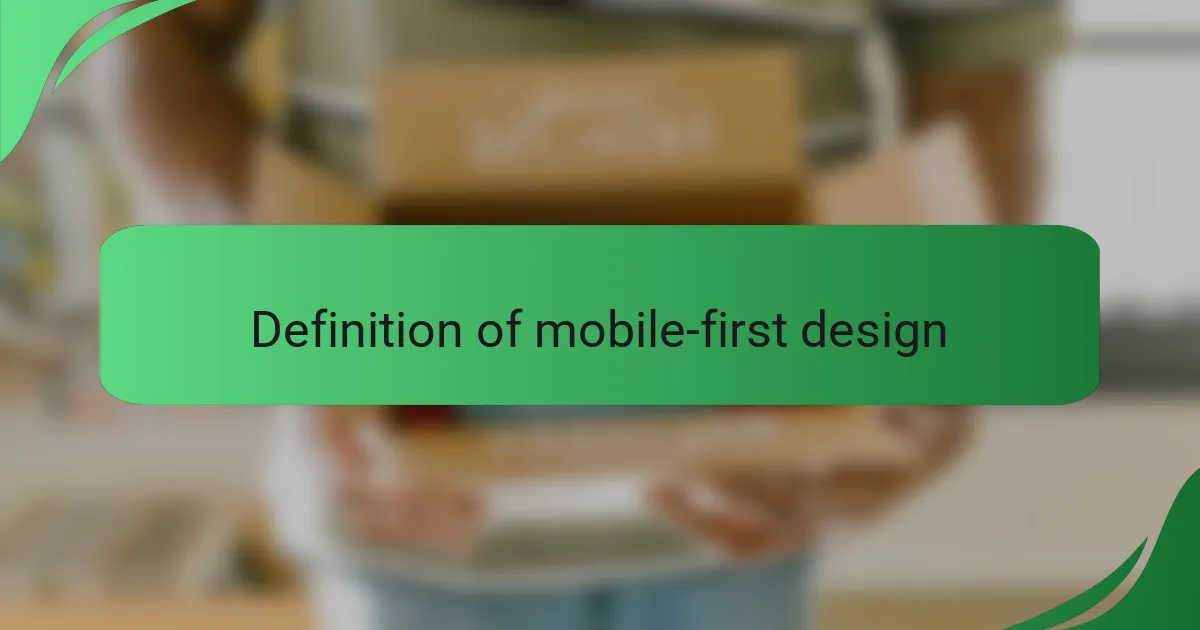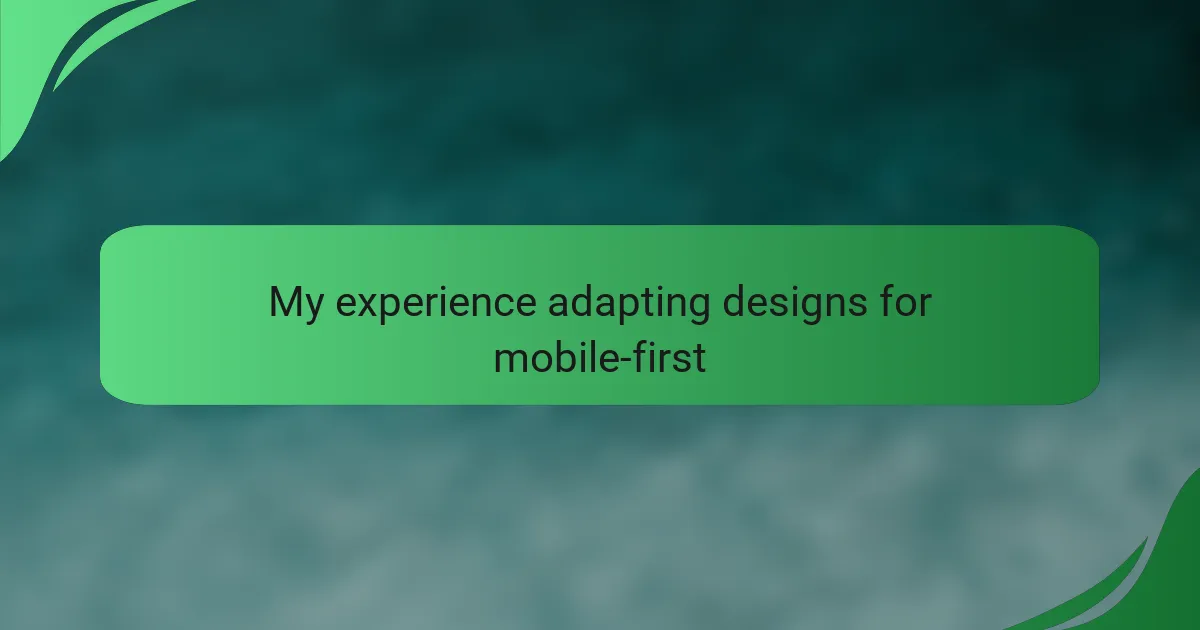Key takeaways
- Mobile-first design prioritizes the mobile user experience, focusing on essential content, simplified navigation, and rapid loading times.
- Key principles of effective mobile interface design include simplicity, consistency, accessibility, and responsiveness to various screen sizes.
- Common challenges in mobile design encompass limited screen space, the need for balanced performance, and ensuring usability across diverse devices.
- Utilizing tools like Figma and Google’s Material Design guidelines enhances collaboration and informs design decisions, aiding in the creation of user-centered mobile experiences.

Definition of mobile-first design
Mobile-first design is a strategy that prioritizes the mobile user experience before considering desktop interfaces. I recall when I first grasped this concept; it felt like a revelation. Instead of just resizing existing designs, I learned to think differently about how users interact with content on smaller screens. This shift in perspective greatly influenced my design process and made me more empathetic toward mobile users.
To effectively implement a mobile-first approach, I found it helpful to keep these principles in mind:
- Focus on essential content: Identify what is crucial for mobile users and streamline information.
- Simplify navigation: Use clear, easily accessible menus to enhance usability on smaller screens.
- Prioritize loading speed: Optimize graphics and resources to ensure quick loading times, which significantly impacts user satisfaction.
- Emphasize touch interactions: Design for finger taps rather than mouse clicks, ensuring buttons and links are adequately sized.
- Be mindful of screen orientation: Design layouts that adapt seamlessly to both portrait and landscape orientations.

Principles of effective interface design
Effective interface design, especially in a mobile-first context, revolves around a few foundational principles. In my experience, one of the most impactful guiding ideas is simplicity. I remember a project where I removed unnecessary elements from a mobile layout, which not only clarified the user journey but also enhanced user satisfaction. Users expressed their appreciation for a clean, focused interface that allowed them to interact seamlessly without distractions.
Another principle that I’ve found essential is consistency. Every app or website needs to maintain a cohesive look and feel. I recall a time when I designed a navigation system that mirrored common gestures and icons across platforms. This approach not only felt intuitive but also built trust with users, helping them feel more at home while interacting with the interface.
- Simplicity: Prioritize clarity and reduce clutter to enhance user focus.
- Consistency: Maintain uniform design elements to foster familiarity and ease of use.
- Feedback: Provide timely responses to user actions, like animations or alerts, to keep users informed.
- Accessibility: Ensure designs are usable for people of all abilities, accommodating different needs.
- Responsive Design: Create layouts that adapt seamlessly across various screen sizes, enhancing the experience for mobile users.

Importance of user experience
Adapting designs for a mobile-first approach has become essential in today’s digital landscape. I remember when I first shifted my focus to mobile designs; I was surprised by how much the user experience (UX) could shift based solely on the device. Users on mobile are often on the go, and their needs are different from desktop users. This realization ignited my passion for creating streamlined, efficient interfaces that prioritize simplicity and speed.
Moreover, considering UX in mobile design isn’t just about functionality; it’s about building a connection with the user. When I received feedback from users appreciating the intuitive navigation and quick load times, it solidified my understanding of the importance of enhancing user experience. After all, a seamless interaction fosters trust and loyalty.
| Aspect | Desktop Experience | Mobile Experience |
|---|---|---|
| Screen Size | Generally larger, allows for more content | Smaller, necessitates concise information |
| User Context | Users are often stationary | Users are mobile, multitasking, or in transit |
| Interaction | Mouse and keyboard input | Touchscreen input requires larger tap targets |
| Navigation | Can accommodate complex menus | Needs straightforward, simplified navigation |

Common challenges in mobile design
When diving into mobile design, one of the most common challenges I’ve encountered is the limited screen real estate. It forces you to prioritize content, and sometimes, making those tough decisions on what to keep and what to cut can be a rollercoaster of emotions. I’ve had moments where I felt attached to certain design elements, only to realize they cluttered the experience, ultimately detracting from usability.
Another hurdle is maintaining performance and speed across various devices. Compressing images without sacrificing quality has often felt like walking a tightrope. I remember a project where I thought I nailed the design, but the loading times were dragging. It was only through extensive testing that I learned to find the right balance, ensuring users had a seamless experience across different screens.
- Limited screen space leading to tough content prioritization
- Ensuring readability and usability on smaller displays
- Balancing aesthetics with functionality without compromising performance
- Addressing varied device specifications and screen sizes
- Keeping loading times efficient while maintaining quality

My approach to mobile adaptation
When I approach mobile adaptation, I prioritize the user experience above all else. I remember a project where I had to redesign a comprehensive website for mobile use. Initially, it was overwhelming, but breaking down the content into digestible parts helped maintain clarity and engagement.
During this process, I focused on touch-friendly elements, ensuring buttons were easily tappable. I also learned to embrace simplicity; minimizing clutter allowed users to navigate my designs effortlessly. Seeing users interact positively with these mobile adaptations reinforced my belief in user-centric design.
| Aspect | Desktop Version | Mobile Version |
|---|---|---|
| Layout | Multi-column layout | Single-column layout |
| Navigation | Top navigation bar | Hamburger menu |
| Content | Detailed text and images | Concise text, larger images |

Tools and resources I used
Utilizing the right tools has been crucial in my journey to adapting designs for mobile-first. One of my go-to resources is Figma. I remember the first time I used it; the collaborative aspect truly transformed how I approached design. Working with team members in real time allowed us to iterate quickly, ensuring we stayed aligned on user experience. Plus, Figma’s mobile preview function made it easy to visualize how our choices would affect users on smaller screens.
Another resource I frequently use is Google’s Material Design guidelines. These guidelines not only provide a solid foundation for mobile interface design but also inspire creativity. I often find myself returning to these principles when I feel stuck or overwhelmed with a design challenge. They remind me to prioritize functionality while ensuring an engaging user experience. It’s like having a trusted friend who nudges you toward a clear path when the design forest gets dense.
Lastly, I can’t overlook the value of usability testing tools, like Maze. When I first introduced this into my workflow, I was amazed by the insights it provided. Gathering real user feedback helped me refine designs based on actual behavior rather than assumptions. What’s more gratifying than seeing a user easily navigate through a design you’ve meticulously crafted? It’s these tools that anchor my process and foster continuous improvement in my mobile adaptations.




